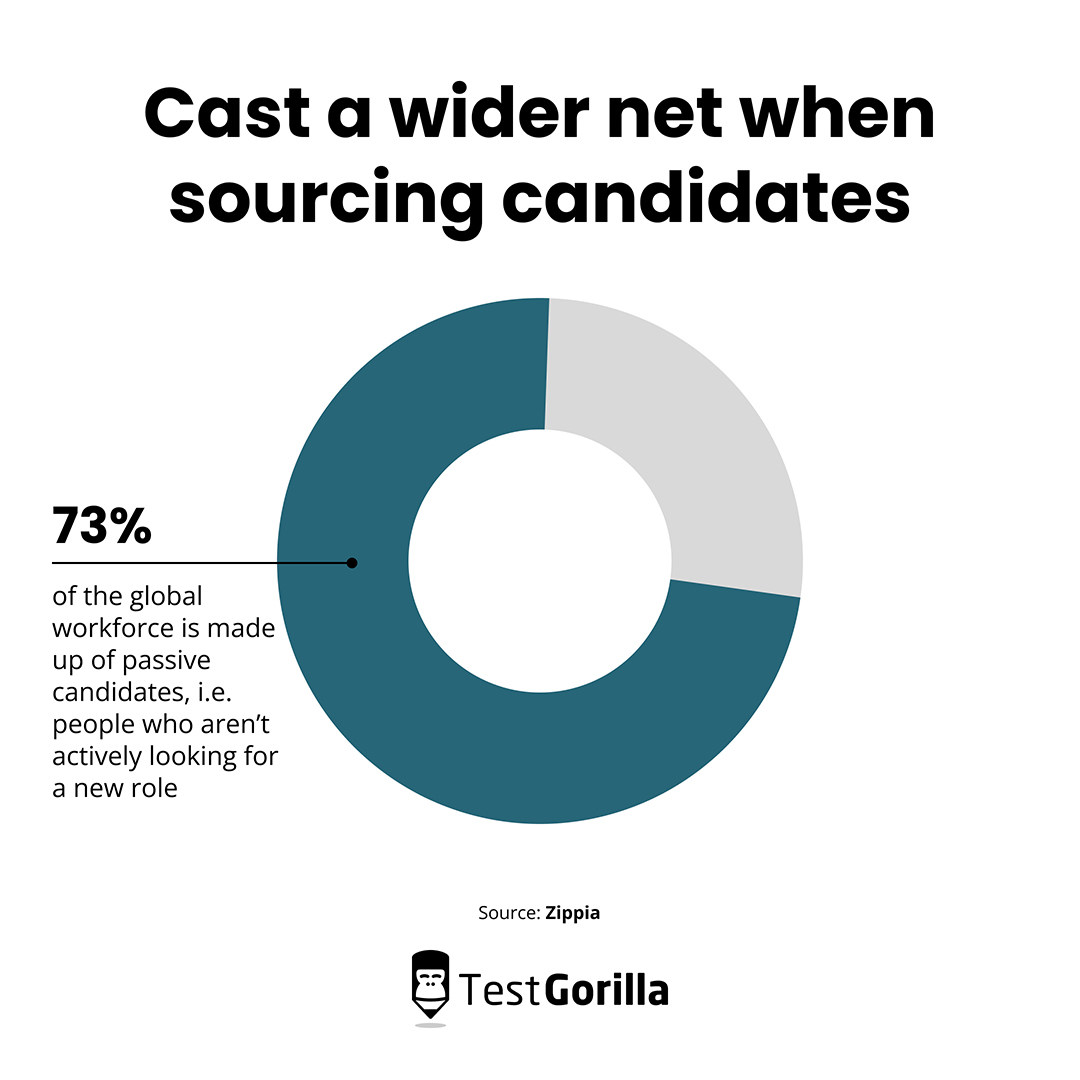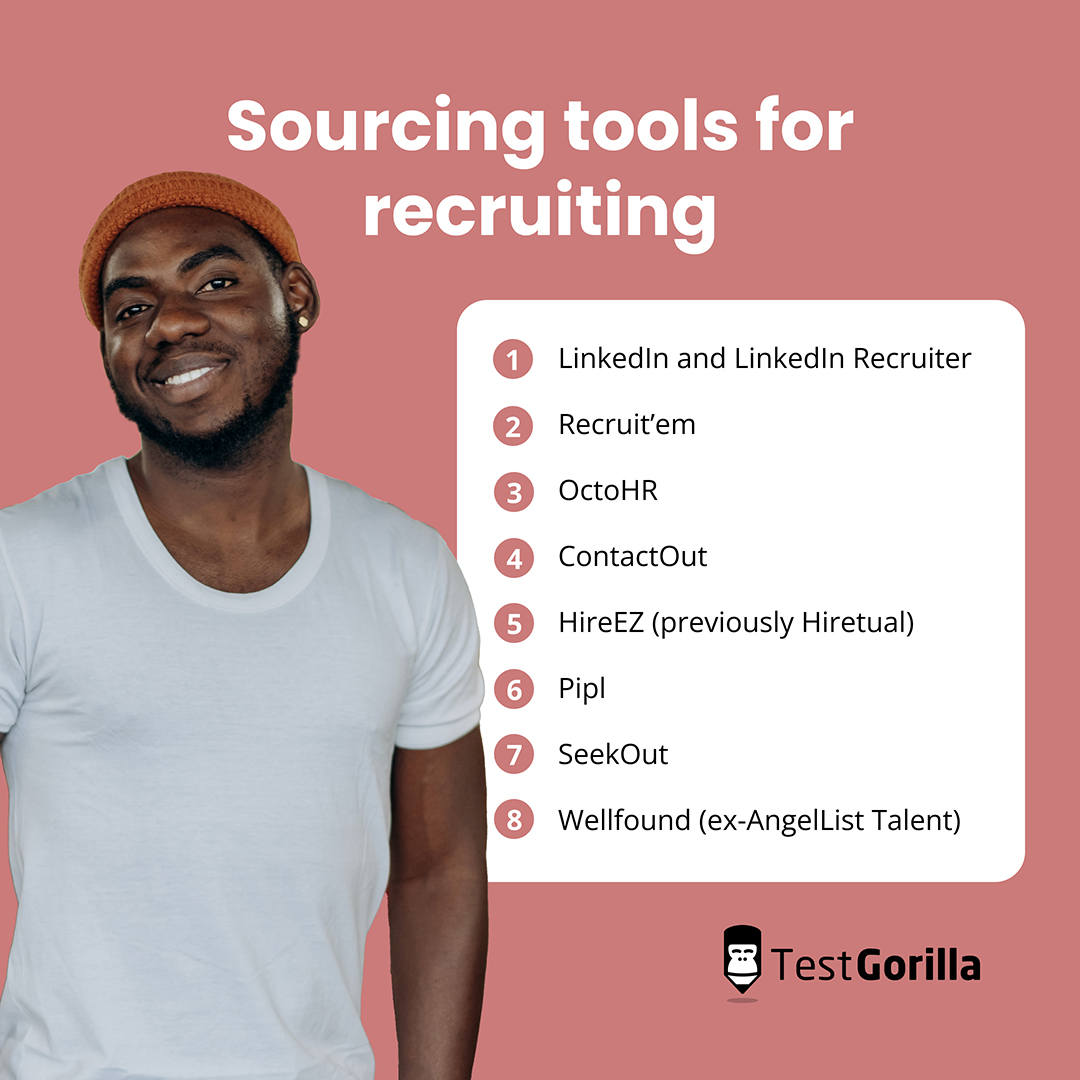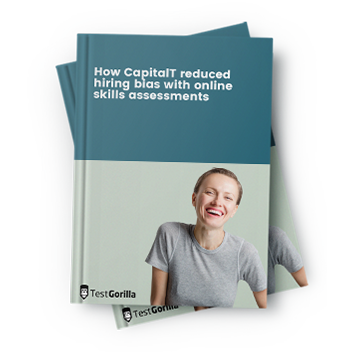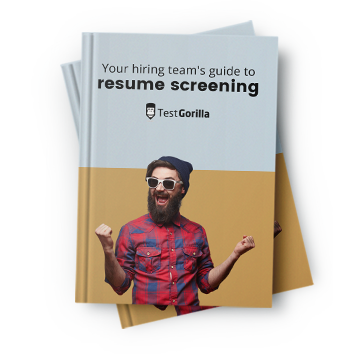It’s no secret that recruitment is as difficult as it is important.
With various studies highlighting the real cost of a bad hire, it’s critical that you get it right, not just for your performance as a recruiter but for the success of your entire company. Metaphorically speaking, you need to dig your well before you're thirsty, or build a pool of talented candidates before you need them.
How do you do that, though?
With the best sourcing tools for recruiting that you can find on the market.
There are many sourcing tools to help you streamline your hiring process – and which can be a powerful part of your recruiting arsenal. In this article, we’ll focus on the top eight and give you detailed information on:
How they work
How much they cost
Whether they have a free version available
What their top features are
Who would benefit from each tool the most
Table of contents
- What is a sourcing tool – and how do you use it in recruitment?
- How do sourcing tools work?
- How to source active and passive candidates with sourcing tools
- Top 8 sourcing tools for recruiting – and who can benefit from each one
- Free vs. paid sourcing tools: What should you pick?
- Use the right sourcing tools to recruit top talent
What is a sourcing tool – and how do you use it in recruitment?
A sourcing tool is a software application or a platform you use to build and curate your pool of candidates. Sourcing tools are helpful to companies who actively build and nurture their talent pools, irrespective of current vacancies.
When they have an opening, these companies already know what type of person they want to hire and have a pool of potential candidates to draw from. That all happens before they even publish a job posting.
In short, although you can use sourcing tools to support specific hiring initiatives, they’re even more valuable if you use them before you start hiring. This requires you to:
Define what sort of talent you’re looking for
Build a database of potential passive candidates
This takes a bit more planning but can be well worth the extra effort.
For example, suppose a company has a key employee leave abruptly. If they have to start from scratch, it could take quite a long time to find the right hire and onboard them.
However, if the company has been proactive in nurturing their talent pool with the help of the right sourcing tools, they can quickly generate a shortlist of prospective candidates and invite them to apply – and then use pre-employment skills testing to evaluate their skills and find the best match.
In short, if you already have a list of potential matches lined up in your sourcing tool, you’ll be able to keep your time to hire low and stay agile and competitive.
And the faster you can recruit someone, the earlier your candidate can give notice to their current employer and begin working at your company. That leads to a shorter gap between someone leaving and you filling their position.
While this sounds amazing in theory, it’s a process you must commit to in the long term if you want to succeed. Sourcing tools are just that: a tool. They can play a part in a larger recruitment strategy, but they won’t do the work for you. You still need to actually source your candidates, evaluate their skills with skills tests, and pick the right person for each role.
That said, sourcing tools can help you streamline the recruitment process significantly, especially if you use them with the right HR tech stack, featuring applicant tracking systems (ATS) like Greenhouse and talent assessment platforms like TestGorilla.
How do sourcing tools work?
Sourcing tools allow you to search for potential candidates based on a variety of criteria, including:
Specific technical skills
Current or past roles
The company they work for currently – some companies build their recruitment strategy on a foundation of recruiting from competitors
General or specialist qualifications
Experience in working with specific software or on particular types of projects
Some sourcing tools target candidates in specific fields. For example, they may focus exclusively on candidates for IT roles. This can be beneficial if you want to start with candidates who are already working or seeking opportunities in your industry. You can then apply different filters to narrow down your search.
How to source active and passive candidates with sourcing tools
According to Zippia’s research, 73% of the global workforce is made up of passive candidates, i.e. people who aren’t actively looking for a new role.
While passive candidates may not be looking to change employers, they still may be open to discussing new opportunities. Even if they’re not, building a relationship with them now can put your company at the top of the list when they start looking for a new role in the future.
Some sourcing tools that enable you to differentiate between active and passive candidates.
The candidates you prioritize should be based on your current needs. Are you trying to fill a current vacancy? Or are you just building up a pool of talented candidates to nurture for future vacancies?
If you’ve got an immediate need, active candidates are your best bet, but you can cast a wider net when you’re operating at full capacity.
Top 8 sourcing tools for recruiting – and who can benefit from each one
Below, you’ll find our list of the top 10 sourcing tools you can find on the market. They’re either free or have a free trial or freemium version, so you can get an idea of whether they fit into your hiring process.
While the potential benefits of using sourcing tools are clear, you still need to ensure you choose the right tool to fit your recruitment strategy. Let’s look at some free and paid sourcing tools you might want to consider.
1. LinkedIn and LinkedIn Recruiter
LinkedIn is the most popular professional network out there – and is also widely used for talent sourcing. With it, recruiters can search for candidates using various filters and then reach out to them directly.
You can use LinkedIn’s search engine for free and view profiles from your extended network (up to a 3rd-degree connection). You can also send connection requests and add a quick note to each one to introduce yourself and make a good first impression. You can then save profiles in a PDF and make your own database or add them to an applicant tracking system (ATS).
For organizations who hire new talent regularly, LinkedIn Recruiter is a better fit. With it, you can get access to all LinkedIn members – of which there are more than 870 million, according to LinkedIn – and reach out to them. For this, you have 150 messages per month and InMail. Additionally, you can use over 40 search filters to find the best candidates.
You can also opt for LinkedIn Recruiter Lite, which is a cheaper version of LinkedIn Recruiter and a good fit if you need to hire up to five people per year.
Top features:
One free job posting and unlimited job postings with the paid plan
20 to more than 40 search filters (in the paid version)
Recommended matches, based on your hiring goals
Talent Insights enables you to compare candidates easily
Pros:
LinkedIn is the biggest professional network and search engine
You can use the platform’s search filters to find talent with very specific skills
You can communicate with candidates via the platform
Cons:
Paid plans are expensive, which can be prohibitive for small businesses
Customer support might be slow to reply
Free plan available: Yes
Pricing: You need to contact LinkedIn’s team for pricing information
Best for:
Small businesses looking to recruit only occasionally (free or Recruiter Lite plan)
Headhunters and large organizations looking to nurture a talent pool (LinkedIn Recruiter)
2. Recruit’em
Recruit’em, formerly known as RecruitIn, is a comprehensive yet easy to use sourcing tool – and the brainchild of a digital recruiter.
Recruit’em uses Google to search profile pages across six platforms:
LinkedIn
Dribbble
GitHub
Xing
Stack Overflow
X (ex-Twitter)
You can then use the results to generate a database of potential candidates. On the downside, you cannot search across all platforms simultaneously because each option contains different search fields.
Recruit’em is 100% free. You don’t need to register and there aren’t any ads on the website. Additionally, the platform also has a free job ad optimizer that will generate suggestions for keywords to include in your ads, based on candidates’ search data.
Top features:
Intuitive interface enabling you to leverage Google Search to find potential candidates across six different platforms
You can save your most frequent searches
Pros:
Enables you to search across six professional platforms (LinkedIn, Dribbble, GitHub, Xing, Stack Overflow, and X) for free
Very easy to use
No ads and no registration required
Focuses on a smaller number of filters, making searches easy to set up
Cons:
You cannot perform a cross-search on two or more platforms
You cannot save search results directly on the platform; you need to build your own database
The platform uses Google Search, so any potential candidates who have set their profiles to private will not show up
It doesn’t offer a way to differentiate between active and passive candidates.
Free plan available: Yes, the platform is entirely free
Pricing: Free
Best for: Small HR teams who need to make only a few new hires
3. OctoHR
OctoHR calls itself GitHub for Recruiters. It’s a free Google Chrome browser extension (sorry Firefox users), so all you need to do to use OctoHR is go to the website in Chrome and add the extension – and is a great sourcing tool if you’re recruiting software developers.
OctoHR allows you to search GitHub – hence the tagline – and gather information on potential candidates’ areas of expertise, along with their email addresses.
One of its best features is the ability to search for candidates based on their number of GitHub followers. This option effectively gives you a means of finding GitHub developers who have been recommended by their peers.
You don’t need to give up your email address to use OctoHR, and anti-virus software lists it as safe and secure.
Top features:
Non-invasive and secure Google Chrome extension
Enables you to get information about developers, including email addresses
You can search by location and programming language
Pros:
Enables you to search for candidates based on GitHub followers or repositories
Gives you candidates’ email addresses and X accounts (ex-Twitter)
Cons:
Limited to GitHub searches
Only allows searching for expertise in one coding language at a time, although you can see other coding competencies in candidate profiles
Doesn’t offer a way to quickly build a candidate list
Free plan available: Yes, the Chrome extension is 100% free
Pricing: Free
Best for: Hiring managers looking to recruit for software development roles
4. ContactOut
ContactOut calls itself the email search engine, counting Microsoft, PWC, and Alphabet (Google) among its clients. It claims it can find email addresses for 75% of people on LinkedIn.
According to ContactOut, a person is twice as likely to respond to an email than a LinkedIn message. While there is no concrete data supporting this, a Sales Handy study from 2018 highlights that open rates will usually be better for emails than for sponsored LinkedIn InMail messages. That suggests that you’re more likely to establish a line of communication with a candidate through email than LinkedIn.
The most attractive aspect of ContactOut is that you can do everything in one place from your account dashboard. ContactOut also has a Google Chrome browser extension, which can find the contact details of potential candidates at the click of a button while viewing an online profile.
As with many sourcing tools, ContactOut primarily works by fetching data from LinkedIn. However, you can also use it to try to get contact details for profiles you find across the internet.
Top features:
Google Chrome browser extension that enables you to find contact details of candidates while browsing
Search portal with more than 20 search filters
Workflow automation that you can use to add prospects to email campaigns in one click
Pros:
Finds email addresses and contact details of potential candidates – even those who don’t have LinkedIn profiles
Provides a lead management tool enabling you to create individual folders for specific roles or specialties
Offers the ability to contact candidates and manage mail campaigns directly from the tool
Cons:
Doesn’t actually find candidates but rather their contact details
Is at risk of becoming severely limited if LinkedIn stops the company from crawling its data (as LinkedIn often does)
Not all data you get is up to date or accurate
Free plan available: Yes, for up to 4 emails and 2 phone numbers per day
Pricing: Starting at $79/month
Best for: Organizations with established candidate sourcing processes that need to quickly find prospects’ contact information
5. HireEZ (previously Hiretual)
HireEZ (ex-Hiretual) is a sourcing tool that leverages AI technology to help you find candidates and rank them in order of suitability for your role based on the filters you use.
For example, if you want your search to prioritize candidates based on their skills, current job role, qualifications, or professional experience, HireEZ will do this for you.
On top of AI, HireEZ boasts a wealth of features, ensuring you can fine-tune your candidate search and align it to your recruitment goals. For example, if you want to diversify your workforce, you can use HireEZ to source candidates from traditionally underrepresented demographics in your niche.
Top features:
Labor market insights that help you understand the salary you need to offer to attract candidates with specific skills
Competitive intelligence showing you what to include in your job descriptions to attract more interest for your role
The possibility to search application tracking system profiles of past candidates
Pros:
The ability to build ideal candidate profiles and see people who fit the description
Real-time analytics and engagement insights
Works as a full applicant tracking system if you need it to
Cons:
Might have too many “bells and whistles” depending on how elaborate your recruitment strategy is
No easily accessible pricing information – you need to schedule a demo to obtain it
Requires a substantial investment
Free plan available: No
Pricing: Not available on the website
Best for: Large companies looking for an end-to-end solution
6. Pipl
Pipl is not your typical sourcing tool for recruiting. Its primary purpose is to verify identities and mine information available online to prevent fraud – but you can use it to find contact details of candidates, too.
It’s used by financial institutions and online media platforms for everything from tracking down delinquent debts to delivering personalized advertising.
Pipl won’t find candidates for your search, but you can use it to find the contact details of a candidate of whom you only have a name or a profile page. You might find the free version of Pipl is all you need for occasions when you can’t find contact information for potential candidates using other tools.
Top features:
Detailed analytics reports and highly accurate data
User-friendly interface that makes it easy to use
Extensive databases of contact details
Pros:
Not connected to or dependent on a specific network or website, so you can search for anyone you want, assuming they have an online presence somewhere
Has an API that you can integrate with existing tools
Cons:
Doesn’t actually find candidates but their contact details and social media accounts
Requires a substantial investment, especially considering the amount of manual work you will still need to do
Free plan available: No
Pricing: No pricing information provided on Pipl’s website
Best for: Large companies who already have a talent pool but don’t have all candidates’ contact information
7. SeekOut
SeekOut is a versatile talent sourcing platform that offers you an AI-enabled candidate search you can use for your talent acquisition process. It’s particularly effective in recruiting hard-to-find and diverse talent in different industries.
SeekOut’s functionality isn’t limited to sourcing candidates, though – it’s also a talent pool management and talent intelligence tool, enabling you to assess skills gaps and plan your future workforce.
Top features:
SeekOut Assist, a ChatGPT-enabled tool to generate a targeted search and list of suitable candidates
Detailed candidate profiles enabling you to dive deep into candidates’ skills
Helps you find candidates from underrepresented backgrounds and reduce bias
Pros:
800+ million public profiles, of whom 40+ million technical profiles and 97+ million subject matter experts
Enables you to create personalized messages to engage passive talent
Integrates well with other HR tools and HR information systems (HRIS)
Cons:
Primarily oriented towards US and Canada, so companies seeking to hire outside those two markets might find its talent search somewhat limited
Some users have reported lags or glitches in the synchronization of candidate information between websites and the platform
Free plan available: No, however there’s a free Chrome extension of the SeekOut Sourcing Assistant
Pricing: No information available on the website, you need to contact SeekOut’s sales team
Best for: Large HR teams looking to recruit at scale with the help of AI
8. Wellfound (ex-AngelList Talent)
AngelList is a platform that connects startups, angel investors, and partners – and Wellfound is its talent sourcing tool (which was previously known under the name AngelList Talent).
It’s particularly useful for startups looking to recruit niche talent with top technical skills for roles such as software engineers, project managers, graphic designers, sales consultants, and marketers.
Top features:
Access to a large talent pool of 8+ million candidates interested in roles in startups
The paid plan has an add-on called Curated that gives you access to top pre-vetted talent
Free employer pages where you can show your company culture, mission, and values
Pros:
Has a comprehensive free plan allowing you to post jobs, review applications, and connect with your ATS
Focused on roles in the tech startup ecosystem
Has a built-in ATS system
Cons:
Limited utility for non-tech companies
No automated candidate matching
Free plan available: Yes
Pricing: from $499/month
Best for: Startups in the tech industry looking to scale fast
Free vs. paid sourcing tools: What should you pick?
Some sourcing tools, like OctoHR or LinkedIn’s search engine, are free.
If you’re working on a tight budget, free sourcing tools will help you build shortlists and nurture candidates without a large financial investment. This also enables you to test different tools and approaches to see how they would work in your recruitment process.
Or you might just use them as a means of getting a snapshot of the current recruitment landscape in your industry before embarking on your hiring campaign.
With so many free options available, you might wonder why anyone would pay for a sourcing tool. Well, it depends on your recruitment strategy and how you plan to use those tools.
While the free tools are great, there are some limitations. Paid sourcing tools address some of the shortcomings of free tools and provide a range of additional features and benefits that will help you recruit more efficiently.
Use the right sourcing tools to recruit top talent
Despite the recent layoffs in the tech industry, competition for the best candidates remains fierce, so you need to start working on sourcing the best talent today.
But to make the most out of the sourcing tool you pick, you need to determine how it’ll fit into your overall recruitment strategy.
So, what should you do after you source skilled candidates?
The next step is to invite them to apply to your opening and take a skills assessment to evaluate their abilities and expertise fairly and objectively.
TestGorilla enables you to do just that; with our platform, you can combine up to five skills tests from our extensive test library to evaluate candidates for any role.
Try out our platform for free to see for yourself why more than 10,000 companies have trusted us with their hiring – or sign up for a free live demo to talk to one of our experts to see how you can streamline your recruitment process.
Related posts
Hire the best candidates with TestGorilla.
Create pre-employment assessments in minutes to screen candidates, save time, and hire the best talent.
Latest posts
The best advice in pre-employment testing, in your inbox.
No spam. Unsubscribe at any time.

Hire the best. No bias. No stress.
Our screening tests identify the best candidates and make your hiring decisions faster, easier, and bias-free.
Free resources
Anti-cheating checklist
This checklist covers key features you should look for when choosing a skills testing platform
Onboarding checklist
This resource will help you develop an onboarding checklist for new hires.
How to find candidates with strong attention to detail
How to assess your candidates' attention to detail.
How to get HR certified
Learn how to get human resources certified through HRCI or SHRM.
Improve quality of hire
Learn how you can improve the level of talent at your company.
Case study: How CapitalT reduces hiring bias
Learn how CapitalT reduced hiring bias with online skills assessments.
Resume screening guide
Learn how to make the resume process more efficient and more effective.
Important recruitment metrics
Improve your hiring strategy with these 7 critical recruitment metrics.
Case study: How Sukhi reduces shortlisting time
Learn how Sukhi decreased time spent reviewing resumes by 83%!
12 pre-employment testing hacks
Hire more efficiently with these hacks that 99% of recruiters aren't using.
The benefits of diversity
Make a business case for diversity and inclusion initiatives with this data.

























